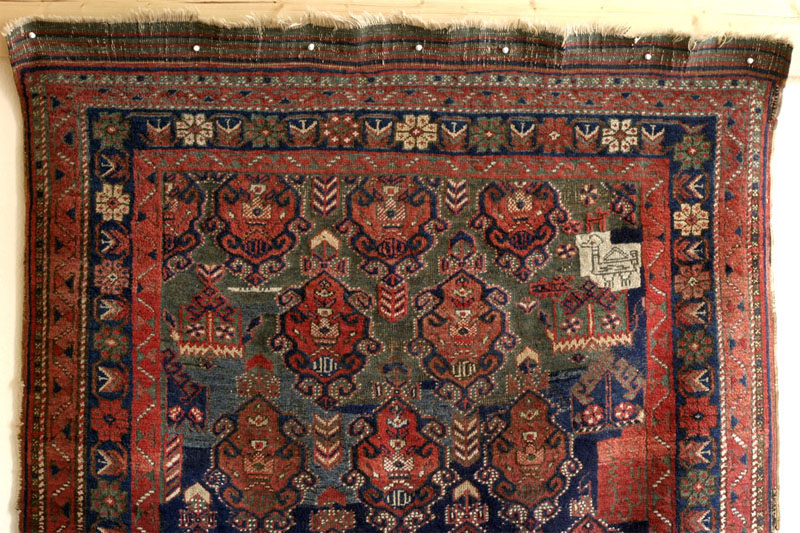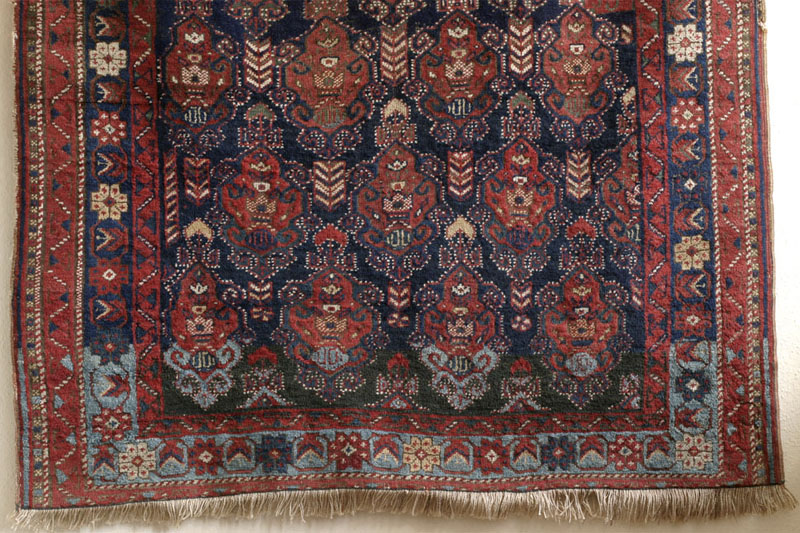This rug is stunning in more than one way: the playful pattern irregularities, the strange inscription and ambiguous date, the inset camel motive, and the abrupt changes in field ground colour (which seem quite rare in Afshar work) make this a very peculiar and unique item.
The field pattern shows diagonally offset rows of stylised palmettes (by some referred to as "shields"), a design type in itself not uncommon in Afshar weaving (compare, for example, Fig. 109 in M. Eiland's 'Oriental rugs - a complete guide' or fig 12.15 in J. Opie's 'Tribal rugs' - both representing a more regular and simpler blueprint of this rug's pattern).
The particular rendering of the palmettes or shield devices in this rug is quite elaborate - each palmette contains a small vase form. Notice also the many inward-curving hooks traced by the dotted outlines which give a pointillistic air to the rug. The main palmette motive is complemented by an alternating narrow grain-, feather- or tree like device which can also be read as the stem of the palmette.
One of the most immediately obvious traits of the field is the colour change from a blueish green at the bottom to saturated indigo in the centre and then, irregularly, to a lighter shade of green towards the top half.
Progressing towards the top, the regular structure of the field pattern loosens up, as if the waever had lost patience with her design and decided to introduce something personal. A red ground cartouche at 90 degrees to the design at the centre right edge of the field has a semiliterate inscription and what appears to be a date, 1372; this, however, makes little sense as it converts to 1952 AD, far too late, while 1272AH would convert to 1855AD which is probably at least 40 years too early. However, since weavers were generally illiterate, it is not unusual to find meaningless dates on tribal weavings.
Further above, the rows of palmettes are flanked by a new motive (for which I find no equivalent) based on a jagged foundation and sporting a tree-like top half of a latch-hooked diamond on a central stem enclosing small rosettes on each side.
Finally and perhaps most prominently, there is an amusing white ground cartouche in the upper right containing a stylised camel.
The colour change in the field is echoed by an equally abrupt colour change in the main border and thin outer guard, which start out sky blue to turn to dark indigo in synch with the field colour change. The simple main border design has stylised rosettes in different colours alternating with blossoms in profile all facing outwards (the latter is reminiscent of the feather-like secondary motive in the field) , all linked by a vine. Secondary borders on both sides employ both a simple geometric meander with inwards and outwards pointing X-shaped devices that look a bit like ski lift or electricity poles. I am not sure how common these are.
The rug measures 5ft.7in. x 4ft.6in. (170 cm x 137 cm). The pile is good, from soft and glossy wool (see pile fold image) though lower in parts of the top half (see section condition and compare images). Symmetric knots, 8 knots horizontal x 8 knots vertical, ca. 64 kpsi. The foundation is very firm, dense and sturdy with moderately depressed warps, the handle flexible but not cloth-like, rather heavy with a strong and elastic feel to it. Warps are thick and strong s-plied cords from two strands of off-white wool. The 2 wefts shots are from a medium brown and in some areas light brown wool, strongly s-plied from 2 strands.
At the top, about 3 inches of the beautiful striped kilim remains (which may be most of it); kilim wefts seem to miss occassionally some single warp threads (see image).
The selvages may largely be original (I am not sure): two cords of 3 z-plied warp threads each, wrapped in a figure 8-shape variously in rose or light brown coloured wool.
The colours appear all based on natural dyes and are saturated and beautiful. There is an nice abrashed madder-based red, different shades of green, two shades of indigo (very dark, and a brilliant sky blue) off-white, and an olive brown, possibly walnut-based or undyed. The blueish green may have been dyed with indigo based sulforic acid.
Good pile, very slight even wear, heavier in the green ground towards the top of the field where some foundation shines through (compare images). If floor use is intended, the top end of the kilim should perhaps be secured though it is not unravelling At the lower end, the outer guard borders and half of the outer secondary border are missing. The lower end is well secured. There are no holes. Apart from the isolated repairs to the selvages (see below) I can see no repairs or repiling.
Selvages: There is one isolated damage or short cut to the selvage at the centre right, and two areas of repair / replacement of the selvage over about 2-3 inches (visible but not obtrusive): one at the centre right immediately above the cut, the other at the top right just below the kilim. Then there is a rather crude re-wrapping of a larger section of the left hand selvage with off-white wool. Below this wrapping, the outer cord of the original selvage seems to be missing in some areas.
The rug is quite clean and without stains or stiff or rotten areas, though it certainly has not been washed recently.










Ein in mehrerer Hinsicht ungewöhnlicher Teppich der Afscharen aus dem Kerman Gebiet, um 1900: Der Farbwechsel im Grund, die Unregelmäßigkeiten im Muster zum oberen Feldende hin, das eingearbeitete stilisierte Kamel auf weißem Grund sowie die rote Kartusche mit einem doppelten Datierung.
Das Feldmuster zeigt stilisierte Palmetten (von manchen auch Schildmotiv genannt), ein häufiges Motiv in Afschar-Arbeiten (z.B., Abb.. 109 in M. Eiland's 'Oriental rugs - a complete guide' oder Abb. 12.15 in J. Opie's 'Tribal rugs' - beide zeigen eine regelmäßigeres und einfacheres Schema wie das dieses Teppichs).
Die Gestaltung der Palmetten ist reich - jede Palmette enthält eine Vasenform. Der Äußere Umriss zeit nach innen gebogene Haken, die von einer gepunkteten Umrißline verziert sind. Dies gib dem Teppich eine pointillistische Anmutung. Das Haupt-Palmettenmotiv wird von einem feder-ähren- oder baumartigen Nebenmotiv im Wechsel begleitet, das ssich auch als Stelngel de rPlmette lesen lässt.
Auffällig der Farbwechsel des Feldes von blau-grün im unteren Bereich zu blau und dann zu einem helleren Grün. Im oberen Bereich löst sich die reguläre Struktur des Musters, als hätte die Knüpferin das Interesse and ihrem gewählten Design veroren und wollte etws Persönliches einarbeiten.
Eine rotgrundige Kartusche, am linken Rand um 90 Grad gedreht ist, enthält eine halbleserliche Inskription und anscheinend ein Datum, 1372; dies macht jedoch keinen Sinn, da es in unserem Kalender 1952 bedeutet, was viel zu spät wäre, während die Lesart 1855 AD sicherlich 40 Jahre zu früh wäre. Da Knüpferinnen häufig Analphabetinnen waren, gibt es in Stammes- und Nomadenteppichen häufiger sinnlose Daten. Interessant und ungewöhnlich das eingearbeitete stilisierte Kamel auf der linken Seite.
Im oberen Bereich findet sich ein neues Motiv (für das ich bisher keine Entsprechung in der Literatur gefunden habe) mit einer gezackten Basis und einer baumartigen Obehälfte aus einer halben Hakenraute auf einem mittigen Stamm, mit kleinen Rosetten zu beiden Seiten.
Der Farbwechsel im Feld wird auch von der Hauptbordüre aufgenommen, die von einem schönen Himmelblau zu Dunkelblau wechselt.
Die Farben sind ausnahmslos gute gesättigte Naturfarben, keine Ausblutungen und keine ausgeblichenen Florspitzen.
Der Teppich misst 170 cm x 137 cm. Guter Flor von weicher und glanzreicher Wolle (siehe Bilder) niedriger im oberen mittigen Bereich. Symmetriische (türkische) Knoten, 8 x 8 Knoten pro Inch x 8 (64 kpsi). Fester und dichtes Grundgewebe mit leicht versenkter Kette, Griff fest, flexibel und elastisch. Kette u. Schuss sind aus Wolle. Am oberen Ende gibt es noch ca 8 cm Kelim. Die Ränder sind wohl größtenteils original.
Der Zustand ist recht gut. Guter Flor, mit leichter gleichmäßer Abnutzung; im oberen Feldbereich ist der grüne Flor etwas korrodiert, vereinzelt ist der Grund sichtbar (siehe Bild).
Am unteren Ende fehlen die äußeren Bordüren. Keine Löcher oder Risse. Ausser vereinzelten Reparaturen an den Seitenrändern gibt es keine Reparaturstellen. Der rechte Rand hat einen kleinen Schaden (in einem Bild gut sichtbar). Teile des linken Seitenrandes sind neu umwickelt worden.